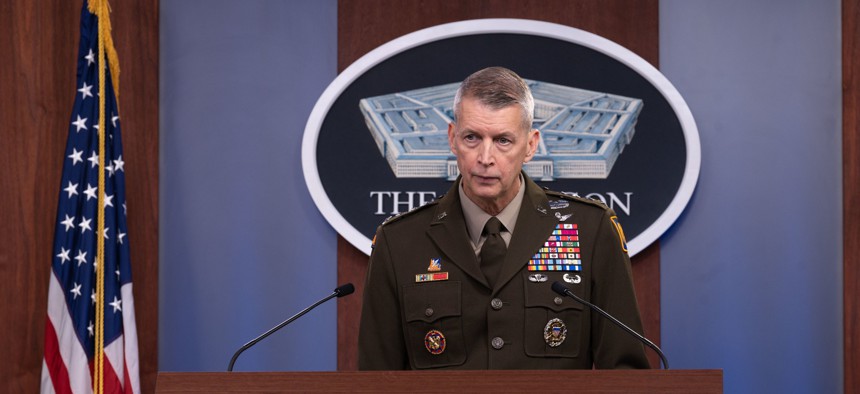Cyber assistance ranks high on National Guard requested services, chief says

Chief of the National Guard Bureau Gen. Daniel R. Hokanson briefs reporters on June 23, 2021. DOD photo by U.S. Marine Corps Sgt. Taryn Escott
Gen. Daniel Hokanson, chief of the National Guard Bureau, said cybersecurity assistance is "one of the most frequently requested things that we're seeing right now" thanks to nearly 4,000 cyber professionals, many of whom acquired their skills as civilians.
Cybersecurity assistance is one of the top requested services from the National Guard, according to its bureau chief.
Gen. Daniel Hokanson, chief of the National Guard Bureau, said cybersecurity assistance is "one of the most frequently requested things that we're seeing right now" thanks to nearly 4,000 cyber professionals, many of whom acquired their skills during their day jobs.
"And the beauty when you look at our cyber formations is, many of these folks, that's what they do on the civilian side. And they really enjoy doing this because it gives them the ability to take their civilian-acquired skills, take them to work and vice versa," Hokanson said during an event at The Heritage Foundation event in Washington, D.C. on May 9.
And those skills are in demand across the National Guard's international State Sponsorship Program, including Ukraine.
"But a lot of our countries that we partner with [they], say hey, can you come help us? And so, this goes back to finding the right team," he said.
"And then we identify that specific guard unit that is most beneficial, whether it's from that state or not. And then we coordinate that training and...or subject matter exchange as quickly as we can. Because we see right now the importance of making sure that your networks are secure."
The National Guard's State Partnership Program includes 87 partnerships across 93 countries worldwide. Hokanson stressed the need to share synthetic training devices or have interoperability with allies and partners, not just when it comes to military exercises, such as being able to navigate a river crossing, but with virtual training capabilities.
Hokanson said the State Partnership Program began heavily incorporating virtual training during the onset of the COVID-19 pandemic and realized the interoperability challenges that came with that.
"Due to COVID, a lot of our partnership engagements for the past two years had to be done virtually," the general said adding that virtual training is " in many ways…more cost effective, particularly if you've got a smaller nation or even a smaller state where they don't have significant budgets, and they need to find that right balance of what you have to do in person and then the same training value that you can gain at lower cost in a synthetic environment," Hokanson said.
The main challenge, he said, is having the synthetic training devices on hand.
"In many cases, we share those or if we don't have that capability, as I mentioned before, linking that partner nation up with a state that does have that. But the key there...kind of goes back to interoperability. The ability for our systems to talk to each other and to work together, not just in a synthetic environment but actually in person as well."
Hokanson said one of his major priorities was getting more training funds so the National Guard could participate in more exercises "where we bring the allies and partners together" – which would improve interoperability. But that takes funding, he noted.
"So the one thing I would really focus on is ensuring that we resource more exercises," he said. "And as we look further in the future, any chance we can to send units like platoons, companies or battalions to train with our allies and partners...it helps us become more interoperable. It gives us more opportunity to work together to understand tactically how we would work together if we ever get into a situation where we're on a battlefield together."






